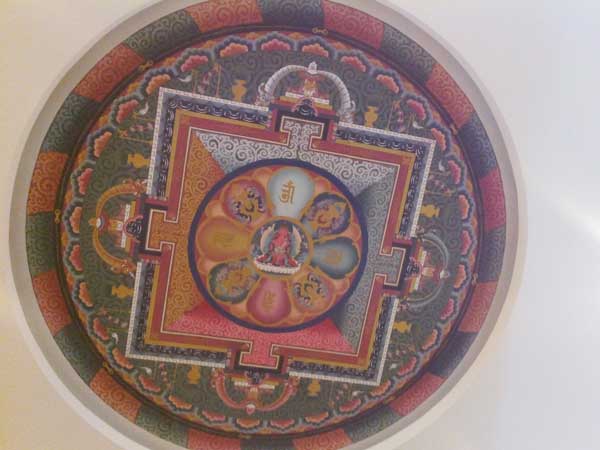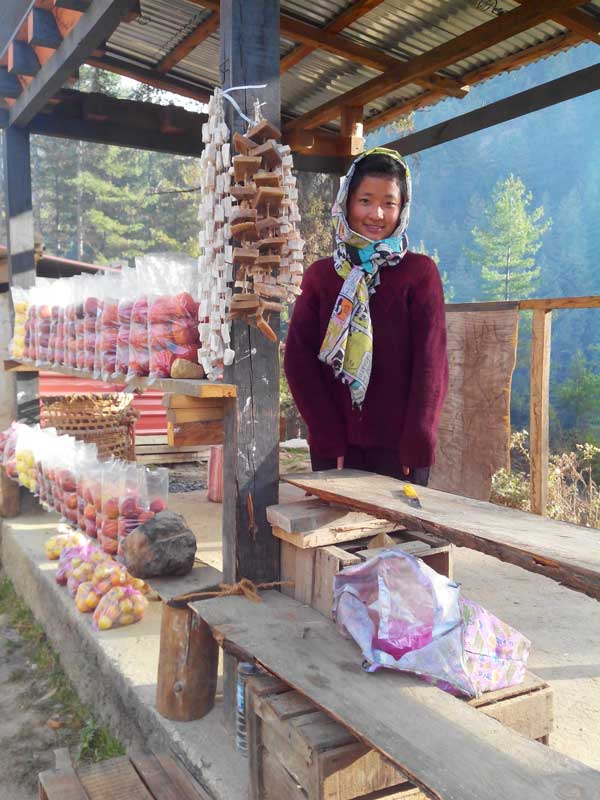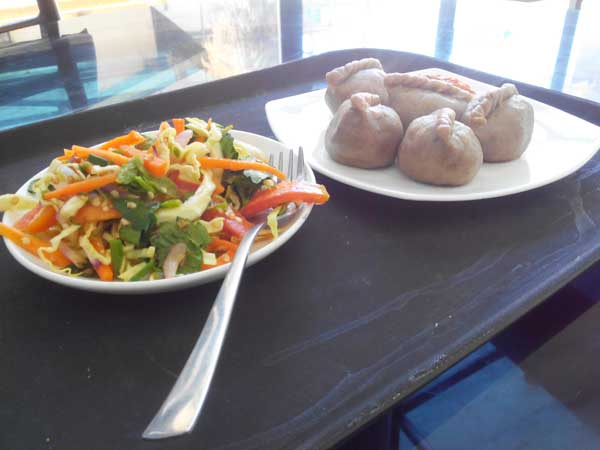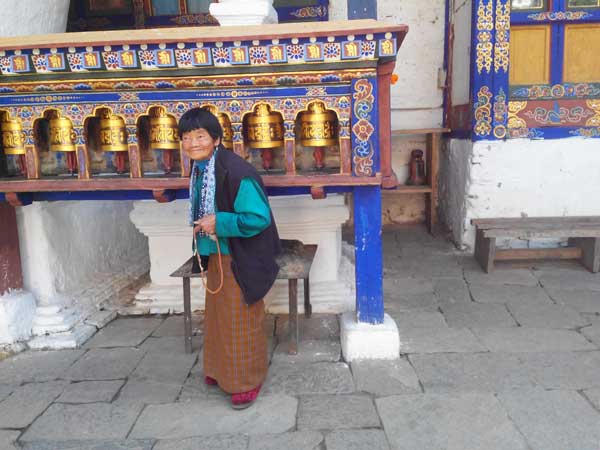
Gliding through fluffy white clouds that kiss the light edging the deep sky-blue heavens, which are turning a high blue, I marvel at the snow-capped peaks peeping out. "There's the Everest!" a voice from a distance calls out. I look, but can't tell which one it is. Anyway, I'll go there another day. Soon, it's time to swoop down to the 'Land of the Peaceful Dragon', and I do, with fellow passengers aboard Drukair, rather smoothly, given the narrow passageway of sub-alpine ranges leading to Paro airport. The November breeze, playing with the gentle Paro Chu (river), greets us as we step out. My spirits lift up further, on noticing that there's no artifice of modern structures to disturb the serenity; the airport proudly showcases Bhutan's traditional Dzong architecture with wooden facades, sloping roofs and colourful thangka paintings that also embellish its interiors. No wonder Bhutan tourism welcomes one and all, saying, 'Happiness is a Place'.
Over the next few days, I discover that in Bhutan, there are many roads to 'Happiness'. My first joyous route (leading to Le Meridien, Thimphu) treats me to the river (changing colour from green to blue), willowy mountains shaded brown and yellow, quaint traditional houses, grazing cows and witty road signs—'Shooting stone drive carefully', 'If you're married, divorce speed' and many more—to punctuate the journey with humour. At first, I'm disappointed with the hotel's minimalistic decor (compared to Bhutanese houses), but its modern depiction of local art grows on me. Even so, their newly opened, traditional-looking Paro property, enveloped in nature, is more my style.

Buddhist mandala painted on the ceiling of Le Meridien Paro's meditation hall
A second happy trail turns out to be next morning's pre-dawn drive up to Dochula Pass. Flanked by cypress trees, it has the odd waterfall, prayer flags and rosy-cheeked ladies selling stringed cubes of yak cheese and freshly plucked green and red apples (some sliced and dried) in translucent, pink polythene bags. The top view leaves me speechless. Imagine 108 stupas against a backdrop of sunlight filtering through the mist, falling on towering conifers, splitting into many beams. It's like a painting. Called Druk Wangyal Chortens, they were built to honour King Jigme Singye Wangchuck's victory over Indian rebels in the 2003 war and in memory of Bhutanese soldiers it killed. Could the hotel have chosen a better spot for a breakfast picnic? On the way back, as luck would have it, we catch a few black yaks grazing.

Rosy-cheeked young lady sells apples and yak cheese post harvest season en route Dochula Pass
People often say the way to a man's heart is through his stomach; well, I'd say the same goes for women. Especially guiltless foodies like me. The idea of stealing some solo time to navigate narrow bylanes of the city's centre to sample the local cuisine thrills me to bits. The roads have no signages to indicate a restaurant is nearby, but buildings at every turn hide interesting small eateries run by young men and women. To my delight, while the Bhutanese love their meat, largely pork and beef, and some chicken, their fare includes a variety of vegetarian dishes. And cheese and chillies find their way into everything! At a local's suggestion I stop at Momo House in Thimphu Plaza and devour 't momos' (that have lovely folds) and cheese momos (also stuffed with diced cabbage and onions) served with stewy ema datse (chilli cheese), not surprisingly Bhutan's favourite dish. One level above, at Yummies, I get a spicy salad and hoentey (buckwheat dumplings filled with shredded turnip, cheese, onion and distinctly flavoured local spices).

Spicy salad with delicious hoentay (buckwheat) dumplings filled with shredded turnip, cheese, onion and distinct flavouring local spices
I'm too full to try more, but the 'Authentic Bhutanese Cookbook' by Punap Ugyen Wangchuk has mouth-watering vegetarian delicacies: soups, butter teas, puta and khur le (buckwheat noodles and pancake), kewa datse (a vegetable of cheese, chillies and potato)... In fact, leafing through the pages, I find terribly tempting dishes for every occasion (like visiting a newborn) and ailment (like healing cracked bones!). Oh, and for picnics—a picnic curry called zachum tshoem. Till now, I thought the hotel's picnic breakfast had European inspirations, but little did I know that picnics are so much a part of the Bhutanese culture. Our picnic lunch is at yet another gorgeous location, by the riverside, at the base of Tango Monastery. As little monks go about their stone-throwing competition, I'm reminded of the warning I'd read earlier, 'shooting stone drive carefully'. LOL.

Buddhist worshipper at Tango Monastery
Now, back to food. So far, in Bhutan, I've seen chillies left to dry on roofs, outside restaurants and even hung on doors (for good luck), but at a small Paro market, I discover they slice and sun dry almost all veggies in preparation for winter—bitter gourd, pumpkin, fiddlehead ferns, beans, you name it. The market has tamarillos, mushrooms of the kind I've never seen (they grow over 100 varieties) and butter from milk of cows, yaks and even mithun (a domesticated ox)! Their cow cheese is similar to cottage cheese. All their produce is organic, but what's imported from India is sold separately. Here too, Amul is a household brand. I purchase so much—packets of dry apple slices, balls of cheese, wild forest honey, zao (similar to puffed rice), red rice, ara (local rice-based alcohol), chillies (very hot, with capsicum's texture) and my best discovery thingey (a strong, wild pepper)—that I have to ship back a carton.
One evening, a local journalist tells me their pastoral society is changing, the youth are moving to salaried jobs. People are leading more sedentary lives, but unchanged food habits are causing health problems. Many pursue higher education in India and don't want to return. A chef who has come back to care for his parents, says, "There's not much happening here." So besides the influence of television and Internet, leading the change such as opening of pizza parlours are those who've had a taste of the world outside. This makes me probe the journalist again, "So are people here happy?" And pat comes his response, "This is a misconception. Happiness is our goal, not our state, and the Happiness Index gives us direction". So while we all continue in our pursuit of happiness, here's a thought: yes happiness can be a place (that's what Bhutan is for me), or many places, but to garner its loyalty we must choose it consciously and give it permanent space, inside us. So choose happiness. Stay cool. Be happy!